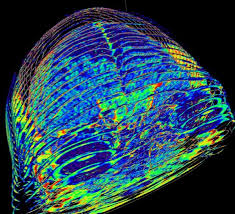
脑电波身份证
"Brainprints" Could Be Future Security ID
脑电波身份证
We all emit slightly different brain waves in response to stimuli, and researchers say that an individual’s specific "brainprints" could be used to validate our identities. Christopher Intagliata reports
在不同的刺激下,我们的大脑会呈现出不同的脑电波图像。研究人员利用此,发明了一套身份识别系统。
撰文/播音 克里斯多夫·因塔利亚塔(Christopher Intagliata)
翻译 李轩
Biometric technology was once the stuff of sci-fi—how many movies show someone having their hand or eye scanned to get entry into a secured facility? But today biometric tech can be found in millions of people's pockets—as the fingerprint scanner on an iPhone.
生物科技曾经仅仅是电影中的科幻元素,我们只能在电影看到这样的场景——一个人只是扫描了一下手掌或者眼睛,安全系统就将其识别?而如今,这样的生物科技已经被装进了千千万万普通大众的口袋,例如iPhone的指纹识别。
Of course, fingerprint scanning isn't foolproof. Hackers have stolen fingerprints from photos, and used fake prints to fool Apple's touch ID. Plus, there’s always the brute force method, like the time a gang in Malaysia cut off a guy's fingertip—with a machete—to interface with the fingerprint-recognition system on the victim's Mercedes.
当然指纹识别并不是万无一失的。黑客可以从相片中窃取到指纹信息,从而使用假指纹骗过iPhone的Touch ID。此外,它还是犯罪的一个诱因,曾经就有一起案件,马来西亚的一个犯罪团伙用砍刀将受害者的指尖切下,开启了装有指纹识别系统的奔驰汽车。
But there's a lesser-known biometric that might be a bit harder to counterfeit: brainwaves. "In the biometric textbook table of contents, often the brain biometrics were listed as ‘Esoteric Biometrics.’ So I guess people have thought about it for many years, but it's been considered sort of esoteric." Sarah Laszlo, a psychologist at Binghamton University, part of the State University of New York.
不过,想必很少人会想到,有一种不容易被伪造的生物识别指标:脑电波。“在计量生物学的课本中,脑电波通常被列入‘很难破译的生物学指标’,所以我猜有很多人虽研究数年,也对其一知半解。”萨拉·拉斯洛说。她是纽约州立大学分校宾汉顿大学的一名心理学家。
To test the potential of brainwave biometrics, Laszlo and her colleagues attached electrodes to the scalps of 45 volunteers. They then recorded an electroencephalogram, or EEG—a reading of the brain's electrical activity—as the subjects watched acronyms flash on a computer screen. Turns out that each acronym—FBI, DVD, VCR—sets off a unique pattern of activation in your brain, which corresponds to an electrical signature. And each person has slightly different so-called "brainprints." Different enough that computers were able to uniquely identify the study volunteers by their brainwaves 94 percent of the time. That effect held up when the subjects were retested six months later. The results are in the journalNeurocomputing. [Blair C. Armstrong et al, Brainprint: Assessing the uniqueness, collectability, and permanence of a novel method for ERP biometrics]
为了挖掘脑电波识别的潜在应用价值,拉斯洛与同事招募了45名志愿者。他们将电极附着在志愿者的头皮上,在志愿者观察电脑屏幕上缩略词时,为他们拍摄脑电图(EEG)——它可以提示出大脑的电流活动。结果显示,每个缩略词——FBI,DVD,VCR——都会引发大脑独一无二的活动模式,就像一种电子签名。每个人的脑电图都会有所不同,这使得电脑可以以94%的正确率分辨志愿者的身份。6月之后,当再次实验,结果仍然如此。这个成果发表在了《神经计算学》期刊上。
Of course 94 percent accuracy won't cut it at the NSA. "I was told by a researcher at a secure cyberspace conference in January that there's something called the rule of 5s. Which means you need 99.99999—five nines, the rule of five—to be used as a practical biometric."
当然,94的正确率并不满足美国国家安全局的要求, “一位参加1月网络安全会议的研究者告诉我,安全领域有一个‘五九原则’,你必须将正确率提高到99.99999,即小数点后还有5个9,才能将识别系统应用于实际。”
But Laszlo and her colleagues are trying out new ideas for upping the test's accuracy. Like showing "pictures of polarizing celebrities, like Kim Kardashian or Kanye West. And also images of foods that some people tend to really like and some people tend to really stay away from, things like sushi." The idea being that polarizing images might elicit more specific brainprints.
不过,拉斯洛与同事们也在不断尝试新方法,提高识别的准确率。比如将缩写词更换成风格迥异的名人的图片,或者一些人喜欢而另一些人不起欢的实物的图片,比如寿司。区分度大的图片或许可以激发更确定的脑电波图。
As for blackmail? "A brainprint, unlike a fingerprint or a retinal scan, is something that would be immune to sort of a gun-to-the-head or blackmail sort of situation. Brain activity changes if you're stressed. That's very well known. And you can cut someone's finger off. But you can't cut someone's brain out. You can't do it." Future spies will simply have to find a way to replicate the brainwaves of their foes themselves. And, actually, one of Laszlo's students is already studying how to do just that.
至于它的安全性呢?脑电波扫描,不同于指纹与视网膜扫描,它完全可以抵御头被枪顶着或者敲诈勒索的情况。在你紧张的时候,脑电波会发生变化,所有人都知道这一点。而且你可以把指头砍下来,但你不可能将头砍下来还让它听你的话。未来的间谍也许需要找到复制敌人脑电波的方法。不过,拉斯洛的一个学生已经开始研究复制方法了。
未经书面许可任何人不得复制或镜像
京ICP备11000850号-1
 京公网安备11010502039775号
京公网安备11010502039775号 信息网络传播视听节目许可证0111611号
国家科技基础条件平台

















